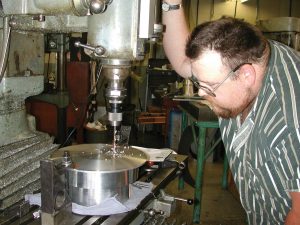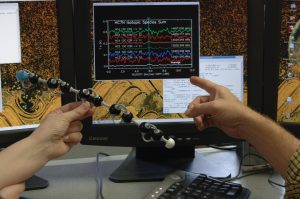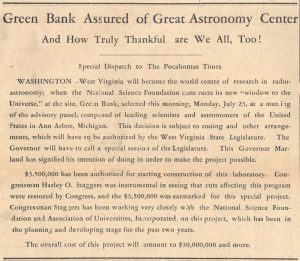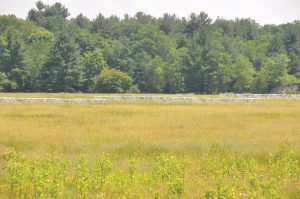Green Bank Machinist Harry Sipe watches carefully as he guides this milling machine painstakingly by hand. Computer-controlled milling machines now installed at Green Bank have sped up this process tenfold.


A Model Molecule and its Spectrum
Much of the work of radio astronomy is detection of the wiggling of molecules. This is the weakest of all energies traveling through space, and yet it tells us incredible details about so many different environments in our Solar System, Galaxy, and other galaxies. A model of a molecule (shown here 500 million times larger than life) spins in a very specific manner, making radio waves as it does. On the screen are the signals we receive when that molecule spins in space.

NRAO Comes to Green Bank News Clipping
This article appeared in the Pocahontas Times in West Virginia when Green Bank was chosen as the new home of the United States’ National Radio Astronomy Observatory.

Panorama with the GBT
The fog rolls around the valley in Green Bank, West Virginia in the twilight hour before dawn. Catching the first rays of the Sun, the 425-foot tall Green Bank Telescope positively glows.

PAPER Antenna
In Green Bank, West Virginia sits a field of 64 of these antennas made by the machinists there. These antennas are searching the distant Universe for the first starlight the Cosmos ever produced, billions of years ago. The project is called PAPER, the Precision Array for Probing the Epoch of Reionization. It is a partnership between NRAO staff scientists and scientists at UC-Berkeley, the University of Virginia, the University of Pennsylvania, and the Square Kilometer Array project (SKA) in South Africa.

PAPER
In Green Bank, West Virginia sits a field of 64 antennas made by the machinists there. These antennas are searching the distant Universe for the first starlight the Cosmos ever produced, billions of years ago. The project is called PAPER, the Precision Array for Probing the Epoch of Reionization. It is a partnership between NRAO staff scientists and scientists at UC-Berkeley, the University of Virginia, the University of Pennsylvania, and SKA South Africa.





